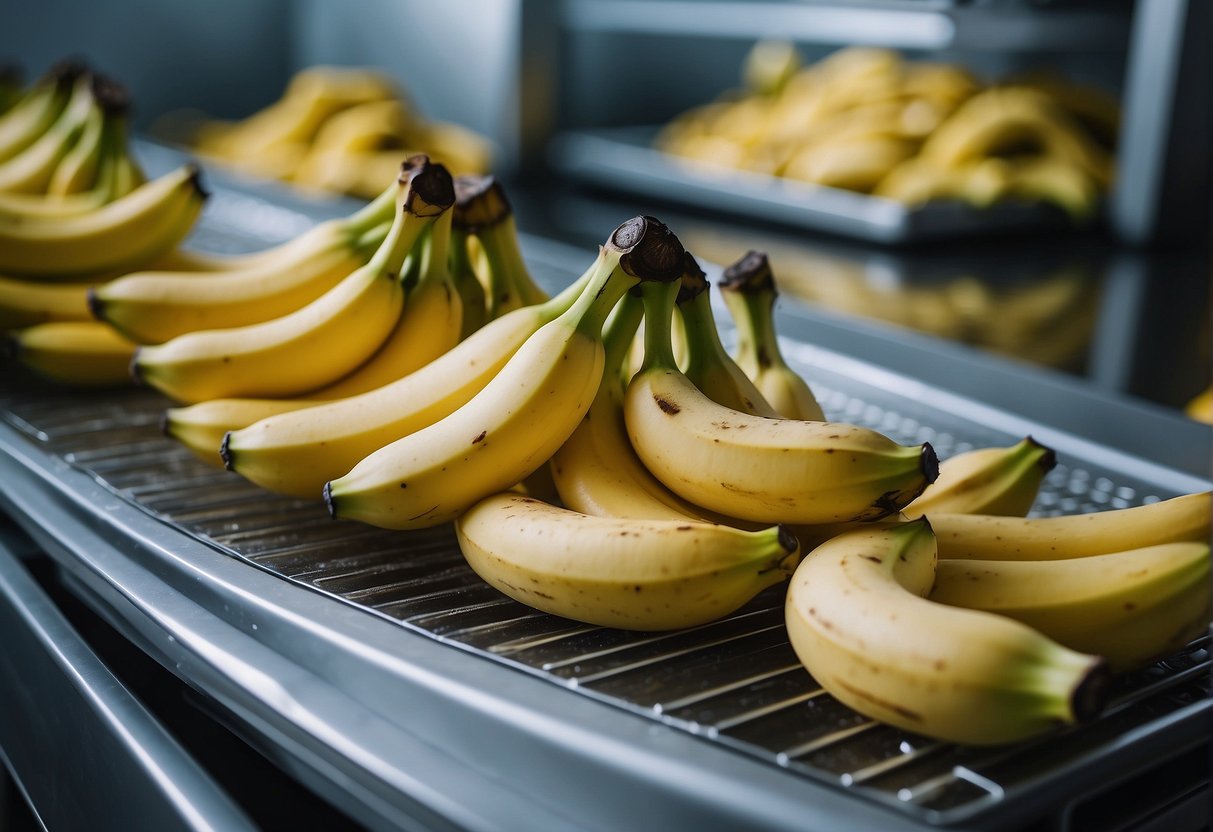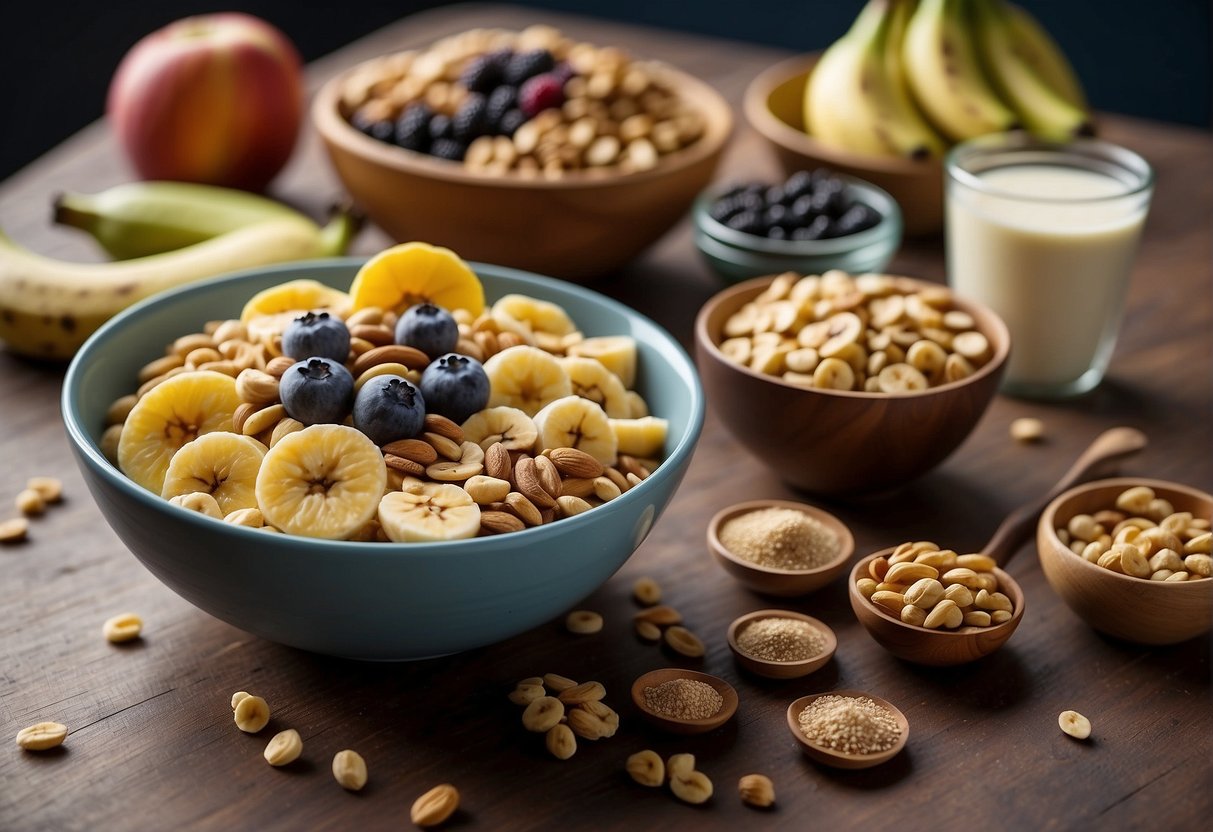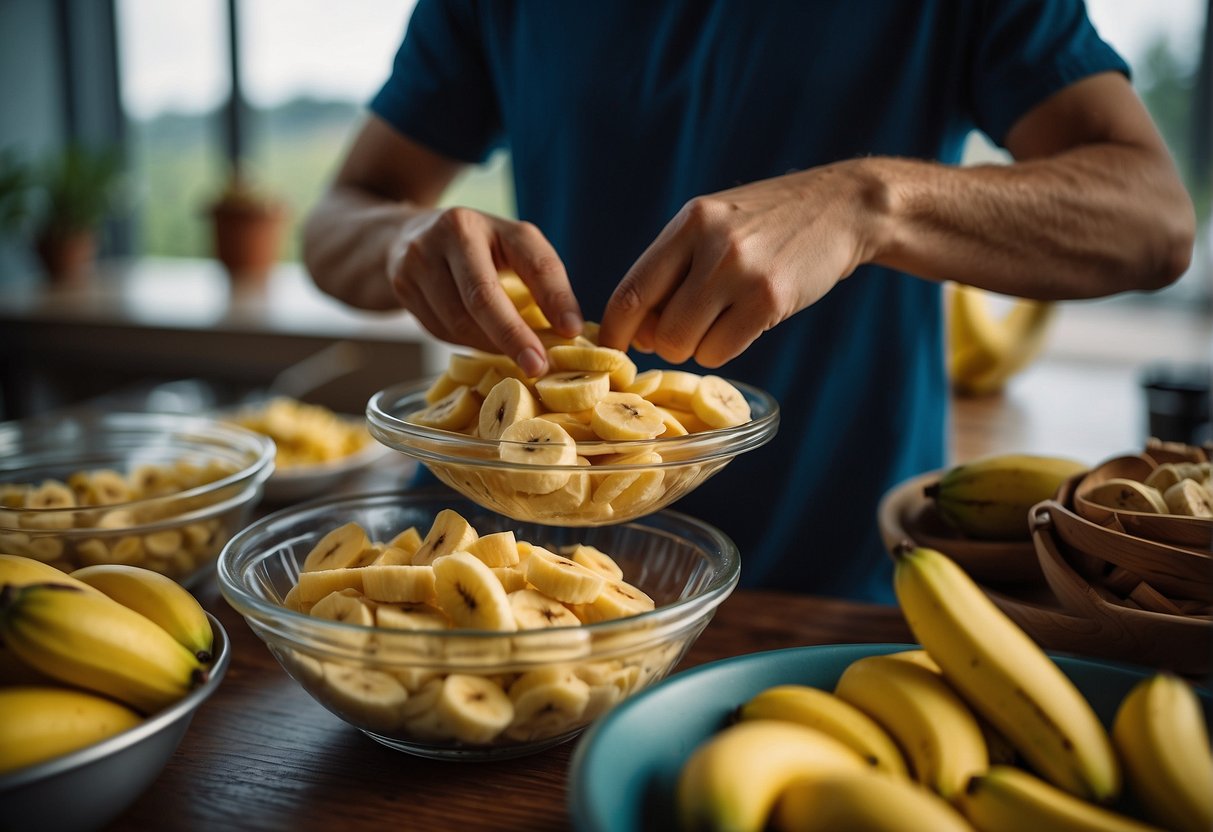Understanding Freeze Drying
When I think about preserving bananas, freeze drying is my go-to method because it maintains flavor and nutrients exceptionally well. It’s like magic, but in reality, it’s just science.
Essential Equipment
Before I start freeze drying bananas, I make sure I have a freeze dryer handy. A freeze dryer is different from a simple dehydrator as it uses the process of lyophilization. During lyophilization, water is removed from the frozen product via sublimation—where water goes directly from ice to vapor. An ordinary dehydrator won’t do because it cannot perform this critical sublimation step.
The Freeze Drying Process
The process begins with me placing the banana slices on the freeze dryer’s trays ensuring they’re not overlapping. How to freeze dry bananas isn’t complicated. I simply run the machine through its typical freeze-drying cycle, which involves lowering the chamber’s temperature to below freezing, then gradually warming to allow the frozen water in the bananas to sublimate. This leaves me with freeze-dried bananas that are crunchy, delicious, and long-lasting.
Preparing Bananas for Freeze Drying

Before jumping in, let me just say that getting your bananas ready for freeze drying is a cinch. You just need to pick the right ones, peel ’em, slice ’em, and lay them out. Let’s walk through these steps together.
Selection and Ripeness
I always start by choosing ripe bananas. They should be yellow with a few brown spots but not too mushy. Why? Because ripe bananas are sweet and tasty, perfect for a delicious freeze-dried snack.
Washing and Peeling
Next up, I wash the bananas thoroughly. Bananas can have dirt and germs on the skin, so this step is pretty important. Then, I grab a knife and peel them carefully. No fancy tools needed here – just peel them like you would if you were about to munch on one.
Slicing and Arrangement
Now comes the fun part: slicing. I aim for slices about ¼ to ½ inch in thickness; it’s the sweet spot for even drying. Then I place them in a single layer on the tray. If they’re touching slightly, it’s okay, but I try to give them some space. Sometimes, I do a quick pre-freezing step by popping the tray in the freezer for a couple of hours. This can give you even better results in the freeze-drying process.
The Drying Phase

In the drying phase of making freeze-dried bananas, I focus on transforming the frozen fruit into a moisture-less state through careful heat and vacuum application. This process ensures the bananas keep their nutritional value and taste.
Pre-freezing
Before I start with the actual freeze drying, I pre-freeze the bananas to make sure they’re completely solid. This step is crucial because it forms the ice crystals that are sublimated during the primary drying. I arrange the slices on a tray without overlap and pop them into a deep freezer, aiming for a temperature well below freezing—think around -30°F (-34°C).
Primary Drying
Now, I shift the frozen banana slices into the freeze dryer. During primary drying, also known as the sublimation phase, I subject the bananas to a low-pressure vacuum. This causes the ice crystals to convert directly into vapor without going through a liquid phase. My machine’s temperature settings are low enough to prevent melting, typically around 95°F (35°C), which is carefully regulated to optimize sublimation.
Secondary Drying
After the primary drying, my bananas still contain some bound water molecules, which I eliminate in the secondary drying phase. Here, I crank up the heat a bit higher to coax out those last bits of moisture. The temperature at this stage goes up to 122°F (50°C), but the vacuum stays on to remove any lingering water vapor. This is what gives the bananas their shelf-stable superpowers, so this step is super important for long-term storage.
Packaging and Storage
After successfully freeze-drying my bananas, I’ve found that proper packaging and storage are crucial for maintaining their shelf life and crispness. Here’s how I make sure they stay fresh:
Sealing in Mylar Bags
I start by carefully placing the freeze-dried bananas into Mylar bags. These bags are excellent because they’re strong, light-blocking, and provide a barrier against moisture and oxygen, which are the nemeses of long-term food storage. I typically use bags that have plenty of space to avoid crushing the bananas.
Adding Oxygen Absorbers
Once my bananas are nestled in the bags, I toss in an oxygen absorber before sealing. This little packet is a game-changer as it scavenges any residual oxygen from the bag, preventing oxidation and extending the shelf life of my crunchy snacks. I make sure the bags are sealed tightly—either with a heat sealer or sometimes a simple iron works for me if a heat sealer isn’t available.
Understanding the Benefits
When I freeze dry bananas, I’m not just preserving their delicious taste—I’m locking in their nutritional benefits and extending their usage much further than a fresh banana could ever go.
Nutritional Value
Banana chips aren’t just a tasty snack; they’re a powerhouse of nutrition. The freeze-drying process retains most of the nutritional value of the bananas. I find that these crunchy treats provide me with dietary fiber, which aids my digestion. They’re also a great way to carry vitamin C and potassium on the go—two essentials for maintaining my health.
Shelf Life and Usage
The most remarkable benefit of freeze-dried bananas is their extended shelf life. I can store them for years without compromising quality, which makes them a perfect healthy snack for my pantry. They’re also an excellent addition to my emergency food supply, offering natural sweetness and energy without the worry of quick spoilage. Whether I munch on them during a hike or add them to my cereal, these banana chips fit into my lifestyle effortlessly.
Creative Uses for Freeze Dried Bananas

I’ve found that freeze dried bananas aren’t just a way to preserve these tropical fruits—they’re a versatile ingredient that can revamp my snacks and recipes with a delightful crunch. Let’s dive into the various exciting ways I like to use them.
Snacking Options
For a quick and healthy snack, freeze dried bananas are a game-changer. I munch on them straight from the bag for that satisfying crunch. Sometimes I make my own trail mix by tossing them with nuts, chocolate chips, and dried berries. They’re not just delicious but also lightweight and easy to carry, which makes them an excellent choice for hikes or as a midday pick-me-up.
Cooking and Baking
In the realm of baking, I’ve discovered that incorporating freeze dried bananas into my pancake mix adds a lovely texture and a concentrated banana flavor. Moreover, crushed banana chips become a perfect stir-in for my granola or can serve as a decorative, tasty topping for banana bread. Their low moisture content means they won’t affect the overall texture of my baked goods.
Beverage Enhancements
My morning smoothie bowls never taste complete without a sprinkling of freeze dried bananas on top. They add a punch of flavor and a delightful crunch that contrasts the smoothness of the blend. Also, I like blending them directly into my smoothies for an extra banana boost. Even my yogurt or ice cream becomes much more exciting when topped with a handful of these crispy banana bits.
Frequently Asked Questions

I get a lot of questions about freeze drying bananas, so I’ve pulled together some common ones to help clear things up for you.
What’s the best method to freeze dry bananas at home?
The best method I’ve found is to use a home freeze dryer. This appliance is specifically designed to freeze dry foods and creates a perfect environment for removing moisture while preserving the banana’s structure and flavor.
Can you walk me through the process of making freeze dried banana chips?
Absolutely. Start by peeling and slicing the bananas. Then, arrange the slices on a tray and pre-freeze them before placing them in your freeze dryer. Once the dryer’s cycle is complete, your banana chips will be ready.
How long does it usually take to freeze dry banana slices?
It can take between 24 to 36 hours. The exact time depends on the thickness of the slices and the model of your freeze dryer. Remember to pre-freeze the slices to shorten the freeze drying time.
In what ways do freeze dried bananas differ from regular banana chips?
Freeze dried bananas are dehydrated using a vacuum process that crisps them up without the need for cooking oil. They retain more nutrients and have a lighter texture compared to regular banana chips, which are typically fried or baked.
What are some tasty recipes that include freeze dried bananas?
Freeze dried bananas make a great crunchy topping for cereals and yogurts. They also blend well into smoothies for an extra kick of flavor. For bakers, they can be ground into banana powder for use in muffins and pancakes.
Just how long can you keep freeze dried bananas before they go bad?
If stored correctly in airtight containers at room temperature, freeze dried bananas can last almost indefinitely. But for best flavor and texture, I’d recommend consuming them within 25 years, as some subtle changes can occur over time.
